Drivers to Maintain Quality Standards in Construction Industry
VerifiedAdded on 2023/01/12
|31
|11001
|61
Report
AI Summary
This report is a proposal for a business and management dissertation, focusing on the drivers for maintaining quality standards of raw materials in the construction industry. It begins with an introduction to the research area, highlighting the importance of quality checks and the impact of structural failures and poor-quality materials. The report outlines the aim and objectives, including analyzing structural failures, the impact of poor-quality materials on the supply chain, and quality management theories. It includes research questions, a theoretical background on the UK construction industry, and challenges faced in maintaining quality. A literature review examines structural failures, the cost associated with such failures, and the impact of poor-quality materials. The methodology section details the research philosophy, design, methods, data collection, sampling, analysis, and ethical considerations. The report concludes with a discussion, conclusion, recommendations, and limitations, offering suggestions for future research. The study aims to provide insights into the factors influencing the quality of raw materials and their impact on the construction industry, using the Battersea Power Station as a case study.
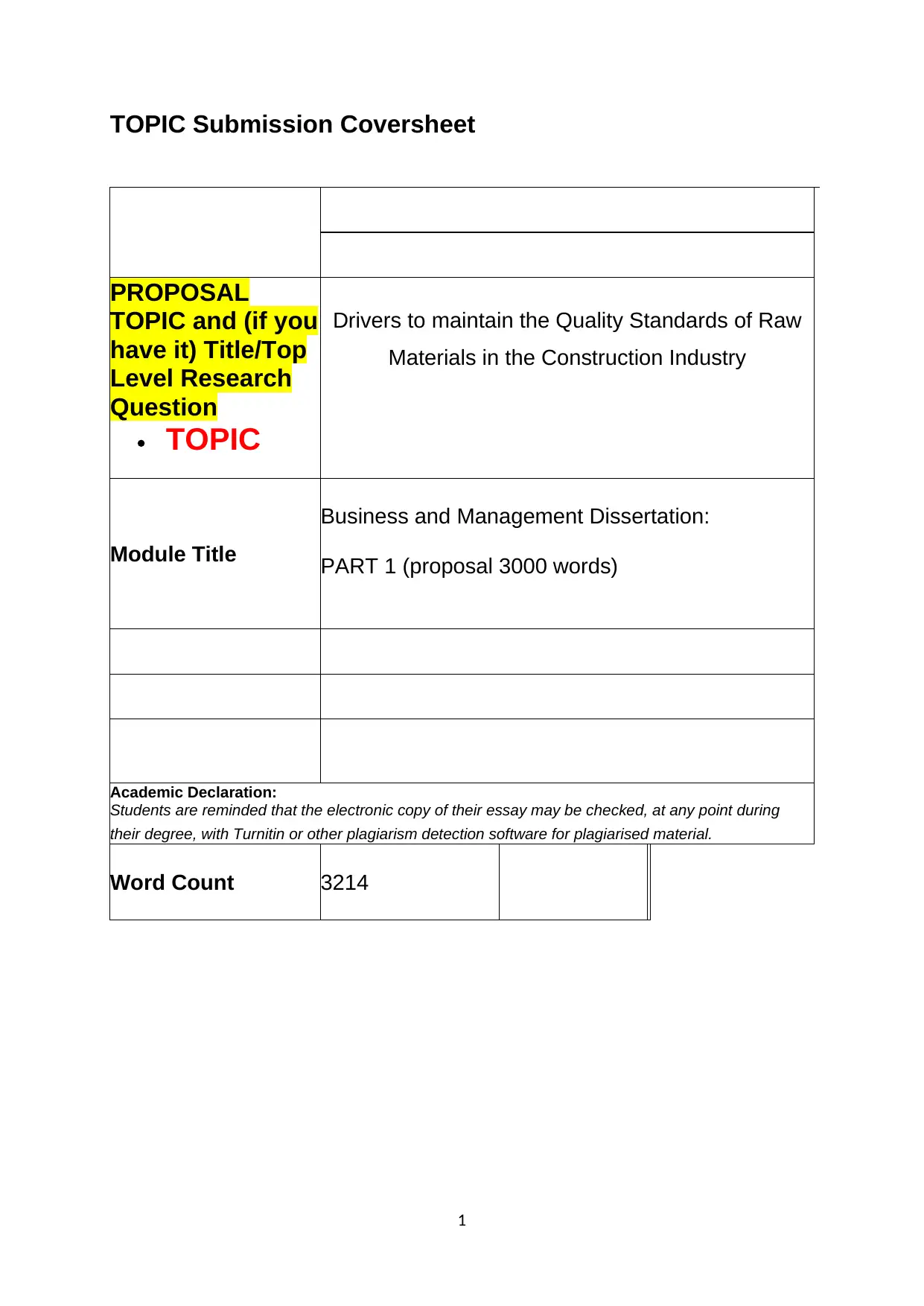
TOPIC Submission Coversheet
PROPOSAL
TOPIC and (if you
have it) Title/Top
Level Research
Question
TOPIC
Drivers to maintain the Quality Standards of Raw
Materials in the Construction Industry
Module Title
Business and Management Dissertation:
PART 1 (proposal 3000 words)
Academic Declaration:
Students are reminded that the electronic copy of their essay may be checked, at any point during
their degree, with Turnitin or other plagiarism detection software for plagiarised material.
Word Count 3214
1
PROPOSAL
TOPIC and (if you
have it) Title/Top
Level Research
Question
TOPIC
Drivers to maintain the Quality Standards of Raw
Materials in the Construction Industry
Module Title
Business and Management Dissertation:
PART 1 (proposal 3000 words)
Academic Declaration:
Students are reminded that the electronic copy of their essay may be checked, at any point during
their degree, with Turnitin or other plagiarism detection software for plagiarised material.
Word Count 3214
1
Paraphrase This Document
Need a fresh take? Get an instant paraphrase of this document with our AI Paraphraser
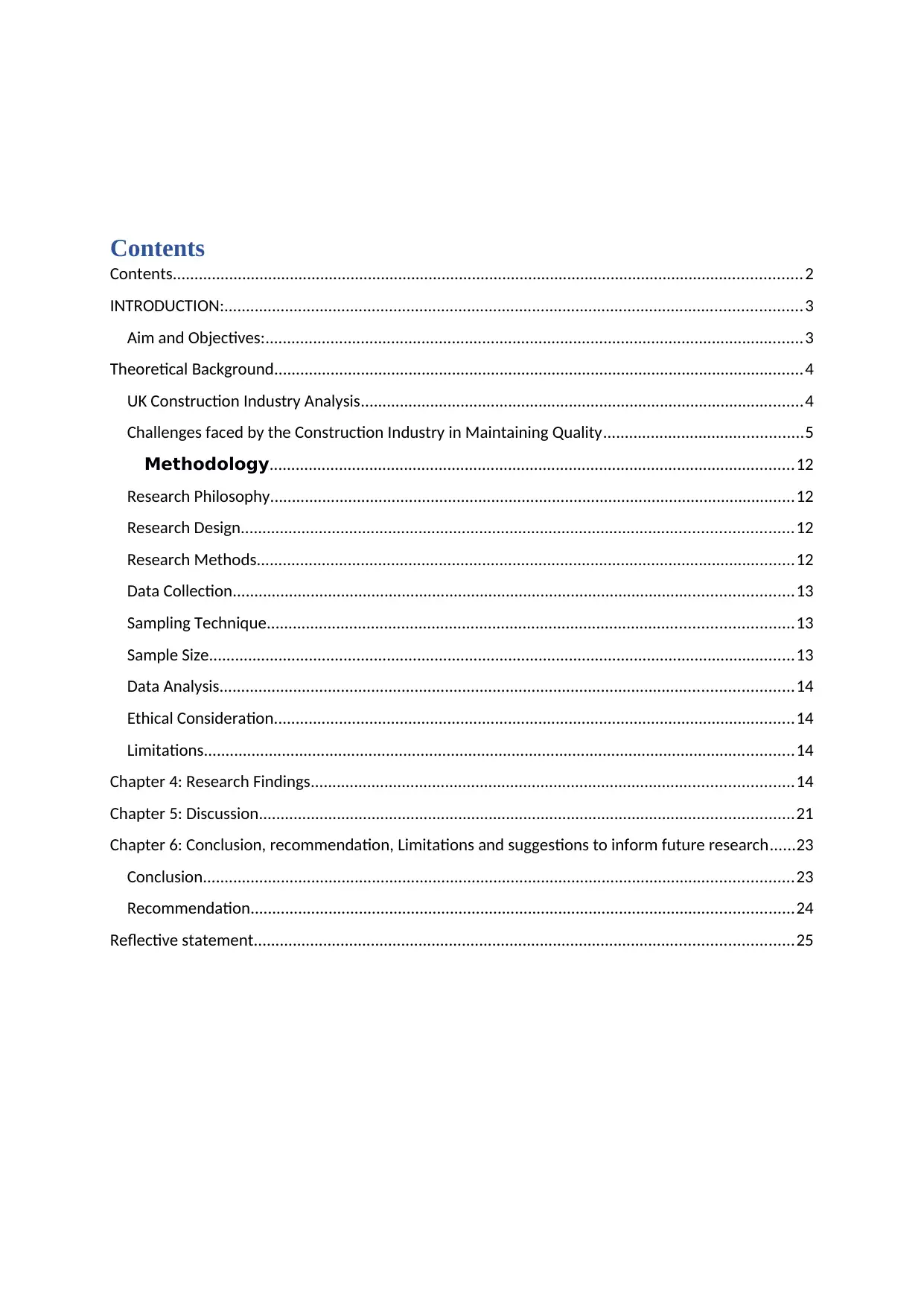
Contents
Contents.................................................................................................................................................2
INTRODUCTION:.....................................................................................................................................3
Aim and Objectives:............................................................................................................................3
Theoretical Background..........................................................................................................................4
UK Construction Industry Analysis......................................................................................................4
Challenges faced by the Construction Industry in Maintaining Quality..............................................5
Methodology.........................................................................................................................12
Research Philosophy.........................................................................................................................12
Research Design...............................................................................................................................12
Research Methods............................................................................................................................12
Data Collection.................................................................................................................................13
Sampling Technique.........................................................................................................................13
Sample Size.......................................................................................................................................13
Data Analysis....................................................................................................................................14
Ethical Consideration........................................................................................................................14
Limitations........................................................................................................................................14
Chapter 4: Research Findings...............................................................................................................14
Chapter 5: Discussion...........................................................................................................................21
Chapter 6: Conclusion, recommendation, Limitations and suggestions to inform future research......23
Conclusion........................................................................................................................................23
Recommendation.............................................................................................................................24
Reflective statement............................................................................................................................25
Contents.................................................................................................................................................2
INTRODUCTION:.....................................................................................................................................3
Aim and Objectives:............................................................................................................................3
Theoretical Background..........................................................................................................................4
UK Construction Industry Analysis......................................................................................................4
Challenges faced by the Construction Industry in Maintaining Quality..............................................5
Methodology.........................................................................................................................12
Research Philosophy.........................................................................................................................12
Research Design...............................................................................................................................12
Research Methods............................................................................................................................12
Data Collection.................................................................................................................................13
Sampling Technique.........................................................................................................................13
Sample Size.......................................................................................................................................13
Data Analysis....................................................................................................................................14
Ethical Consideration........................................................................................................................14
Limitations........................................................................................................................................14
Chapter 4: Research Findings...............................................................................................................14
Chapter 5: Discussion...........................................................................................................................21
Chapter 6: Conclusion, recommendation, Limitations and suggestions to inform future research......23
Conclusion........................................................................................................................................23
Recommendation.............................................................................................................................24
Reflective statement............................................................................................................................25
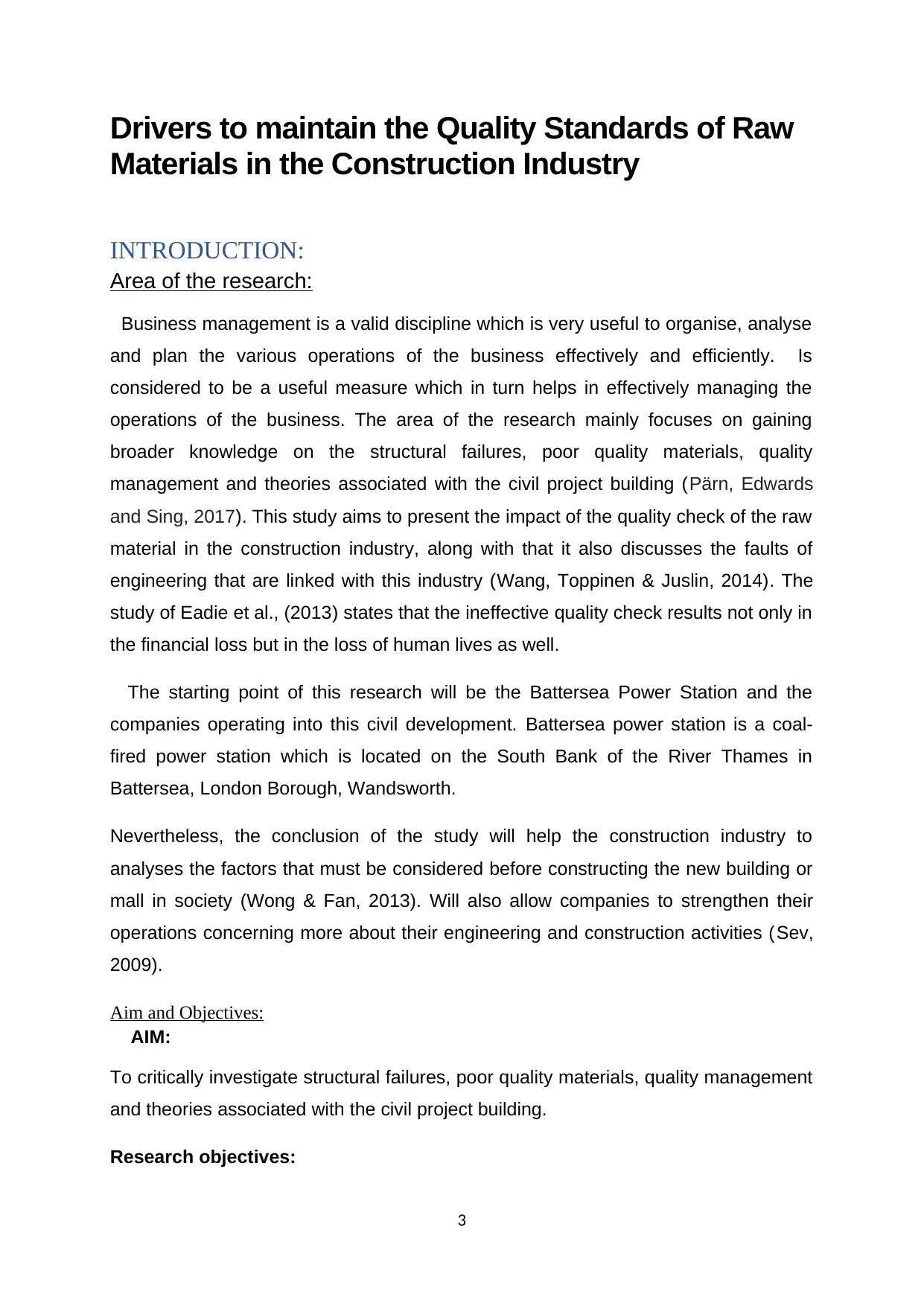
Drivers to maintain the Quality Standards of Raw
Materials in the Construction Industry
INTRODUCTION:
Area of the research:
Business management is a valid discipline which is very useful to organise, analyse
and plan the various operations of the business effectively and efficiently. Is
considered to be a useful measure which in turn helps in effectively managing the
operations of the business. The area of the research mainly focuses on gaining
broader knowledge on the structural failures, poor quality materials, quality
management and theories associated with the civil project building (Pärn, Edwards
and Sing, 2017). This study aims to present the impact of the quality check of the raw
material in the construction industry, along with that it also discusses the faults of
engineering that are linked with this industry (Wang, Toppinen & Juslin, 2014). The
study of Eadie et al., (2013) states that the ineffective quality check results not only in
the financial loss but in the loss of human lives as well.
The starting point of this research will be the Battersea Power Station and the
companies operating into this civil development. Battersea power station is a coal-
fired power station which is located on the South Bank of the River Thames in
Battersea, London Borough, Wandsworth.
Nevertheless, the conclusion of the study will help the construction industry to
analyses the factors that must be considered before constructing the new building or
mall in society (Wong & Fan, 2013). Will also allow companies to strengthen their
operations concerning more about their engineering and construction activities (Sev,
2009).
Aim and Objectives:
AIM:
To critically investigate structural failures, poor quality materials, quality management
and theories associated with the civil project building.
Research objectives:
3
Materials in the Construction Industry
INTRODUCTION:
Area of the research:
Business management is a valid discipline which is very useful to organise, analyse
and plan the various operations of the business effectively and efficiently. Is
considered to be a useful measure which in turn helps in effectively managing the
operations of the business. The area of the research mainly focuses on gaining
broader knowledge on the structural failures, poor quality materials, quality
management and theories associated with the civil project building (Pärn, Edwards
and Sing, 2017). This study aims to present the impact of the quality check of the raw
material in the construction industry, along with that it also discusses the faults of
engineering that are linked with this industry (Wang, Toppinen & Juslin, 2014). The
study of Eadie et al., (2013) states that the ineffective quality check results not only in
the financial loss but in the loss of human lives as well.
The starting point of this research will be the Battersea Power Station and the
companies operating into this civil development. Battersea power station is a coal-
fired power station which is located on the South Bank of the River Thames in
Battersea, London Borough, Wandsworth.
Nevertheless, the conclusion of the study will help the construction industry to
analyses the factors that must be considered before constructing the new building or
mall in society (Wong & Fan, 2013). Will also allow companies to strengthen their
operations concerning more about their engineering and construction activities (Sev,
2009).
Aim and Objectives:
AIM:
To critically investigate structural failures, poor quality materials, quality management
and theories associated with the civil project building.
Research objectives:
3
⊘ This is a preview!⊘
Do you want full access?
Subscribe today to unlock all pages.

Trusted by 1+ million students worldwide
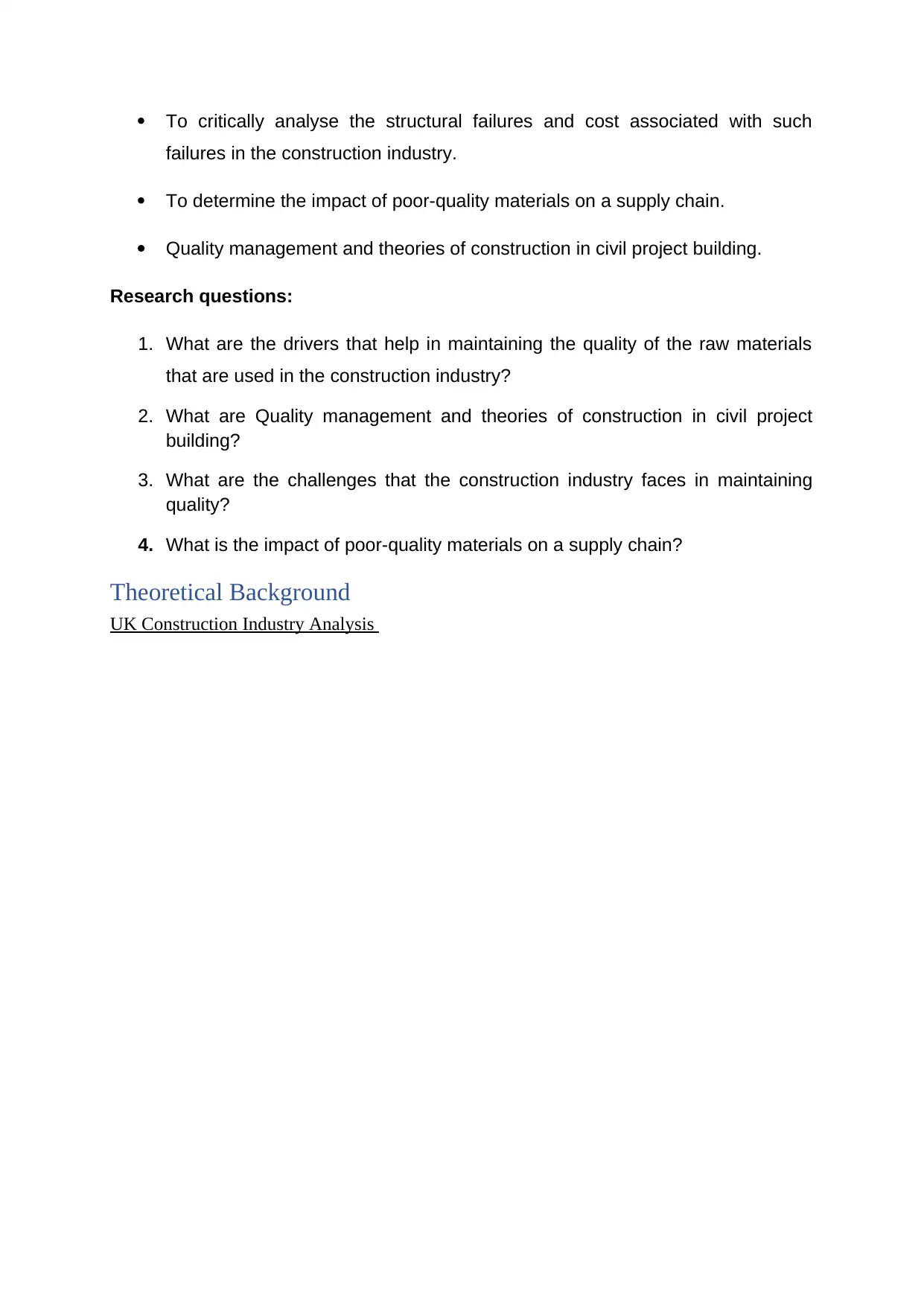
To critically analyse the structural failures and cost associated with such
failures in the construction industry.
To determine the impact of poor-quality materials on a supply chain.
Quality management and theories of construction in civil project building.
Research questions:
1. What are the drivers that help in maintaining the quality of the raw materials
that are used in the construction industry?
2. What are Quality management and theories of construction in civil project
building?
3. What are the challenges that the construction industry faces in maintaining
quality?
4. What is the impact of poor-quality materials on a supply chain?
Theoretical Background
UK Construction Industry Analysis
failures in the construction industry.
To determine the impact of poor-quality materials on a supply chain.
Quality management and theories of construction in civil project building.
Research questions:
1. What are the drivers that help in maintaining the quality of the raw materials
that are used in the construction industry?
2. What are Quality management and theories of construction in civil project
building?
3. What are the challenges that the construction industry faces in maintaining
quality?
4. What is the impact of poor-quality materials on a supply chain?
Theoretical Background
UK Construction Industry Analysis
Paraphrase This Document
Need a fresh take? Get an instant paraphrase of this document with our AI Paraphraser
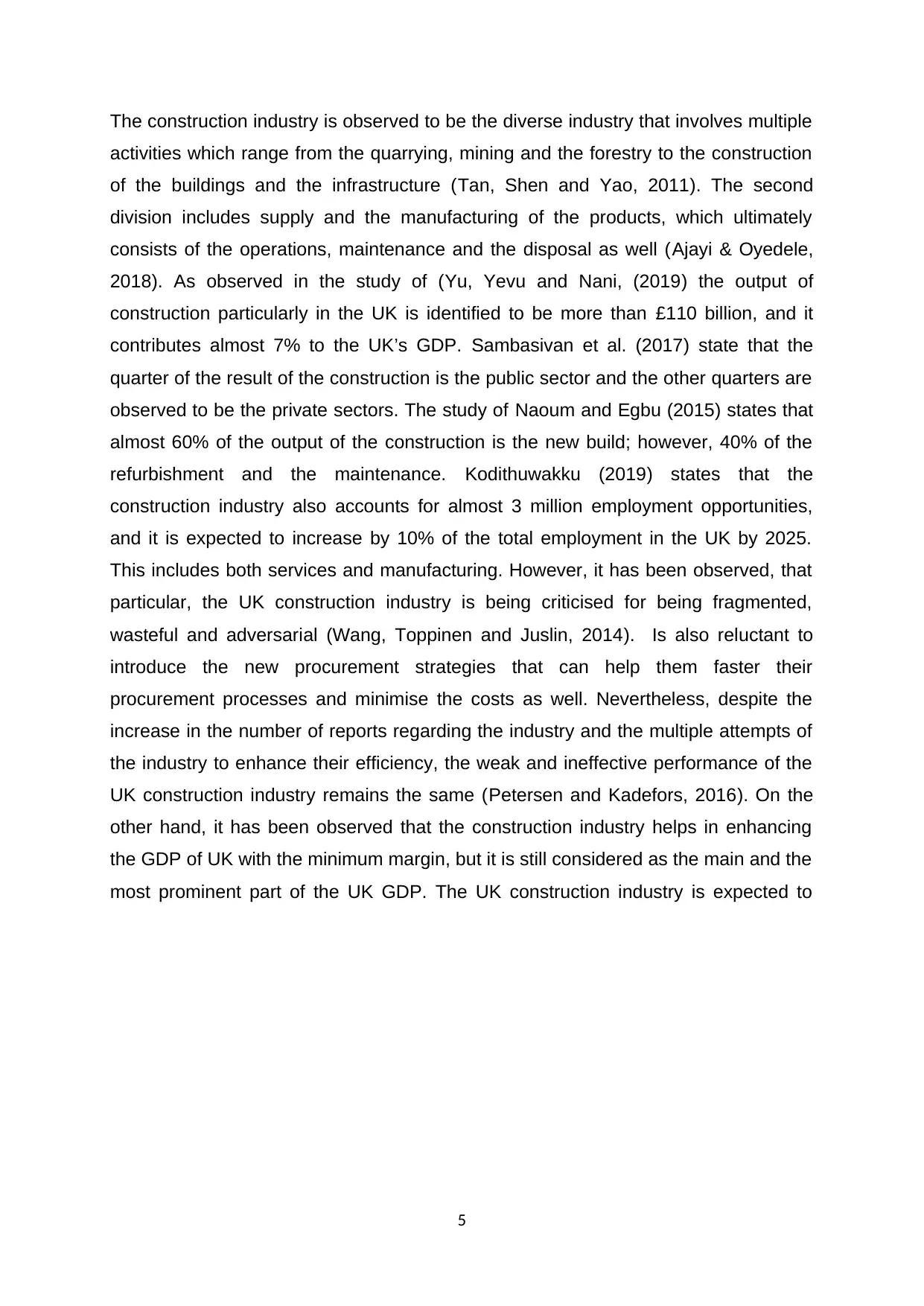
The construction industry is observed to be the diverse industry that involves multiple
activities which range from the quarrying, mining and the forestry to the construction
of the buildings and the infrastructure (Tan, Shen and Yao, 2011). The second
division includes supply and the manufacturing of the products, which ultimately
consists of the operations, maintenance and the disposal as well (Ajayi & Oyedele,
2018). As observed in the study of (Yu, Yevu and Nani, (2019) the output of
construction particularly in the UK is identified to be more than £110 billion, and it
contributes almost 7% to the UK’s GDP. Sambasivan et al. (2017) state that the
quarter of the result of the construction is the public sector and the other quarters are
observed to be the private sectors. The study of Naoum and Egbu (2015) states that
almost 60% of the output of the construction is the new build; however, 40% of the
refurbishment and the maintenance. Kodithuwakku (2019) states that the
construction industry also accounts for almost 3 million employment opportunities,
and it is expected to increase by 10% of the total employment in the UK by 2025.
This includes both services and manufacturing. However, it has been observed, that
particular, the UK construction industry is being criticised for being fragmented,
wasteful and adversarial (Wang, Toppinen and Juslin, 2014). Is also reluctant to
introduce the new procurement strategies that can help them faster their
procurement processes and minimise the costs as well. Nevertheless, despite the
increase in the number of reports regarding the industry and the multiple attempts of
the industry to enhance their efficiency, the weak and ineffective performance of the
UK construction industry remains the same (Petersen and Kadefors, 2016). On the
other hand, it has been observed that the construction industry helps in enhancing
the GDP of UK with the minimum margin, but it is still considered as the main and the
most prominent part of the UK GDP. The UK construction industry is expected to
5
activities which range from the quarrying, mining and the forestry to the construction
of the buildings and the infrastructure (Tan, Shen and Yao, 2011). The second
division includes supply and the manufacturing of the products, which ultimately
consists of the operations, maintenance and the disposal as well (Ajayi & Oyedele,
2018). As observed in the study of (Yu, Yevu and Nani, (2019) the output of
construction particularly in the UK is identified to be more than £110 billion, and it
contributes almost 7% to the UK’s GDP. Sambasivan et al. (2017) state that the
quarter of the result of the construction is the public sector and the other quarters are
observed to be the private sectors. The study of Naoum and Egbu (2015) states that
almost 60% of the output of the construction is the new build; however, 40% of the
refurbishment and the maintenance. Kodithuwakku (2019) states that the
construction industry also accounts for almost 3 million employment opportunities,
and it is expected to increase by 10% of the total employment in the UK by 2025.
This includes both services and manufacturing. However, it has been observed, that
particular, the UK construction industry is being criticised for being fragmented,
wasteful and adversarial (Wang, Toppinen and Juslin, 2014). Is also reluctant to
introduce the new procurement strategies that can help them faster their
procurement processes and minimise the costs as well. Nevertheless, despite the
increase in the number of reports regarding the industry and the multiple attempts of
the industry to enhance their efficiency, the weak and ineffective performance of the
UK construction industry remains the same (Petersen and Kadefors, 2016). On the
other hand, it has been observed that the construction industry helps in enhancing
the GDP of UK with the minimum margin, but it is still considered as the main and the
most prominent part of the UK GDP. The UK construction industry is expected to
5
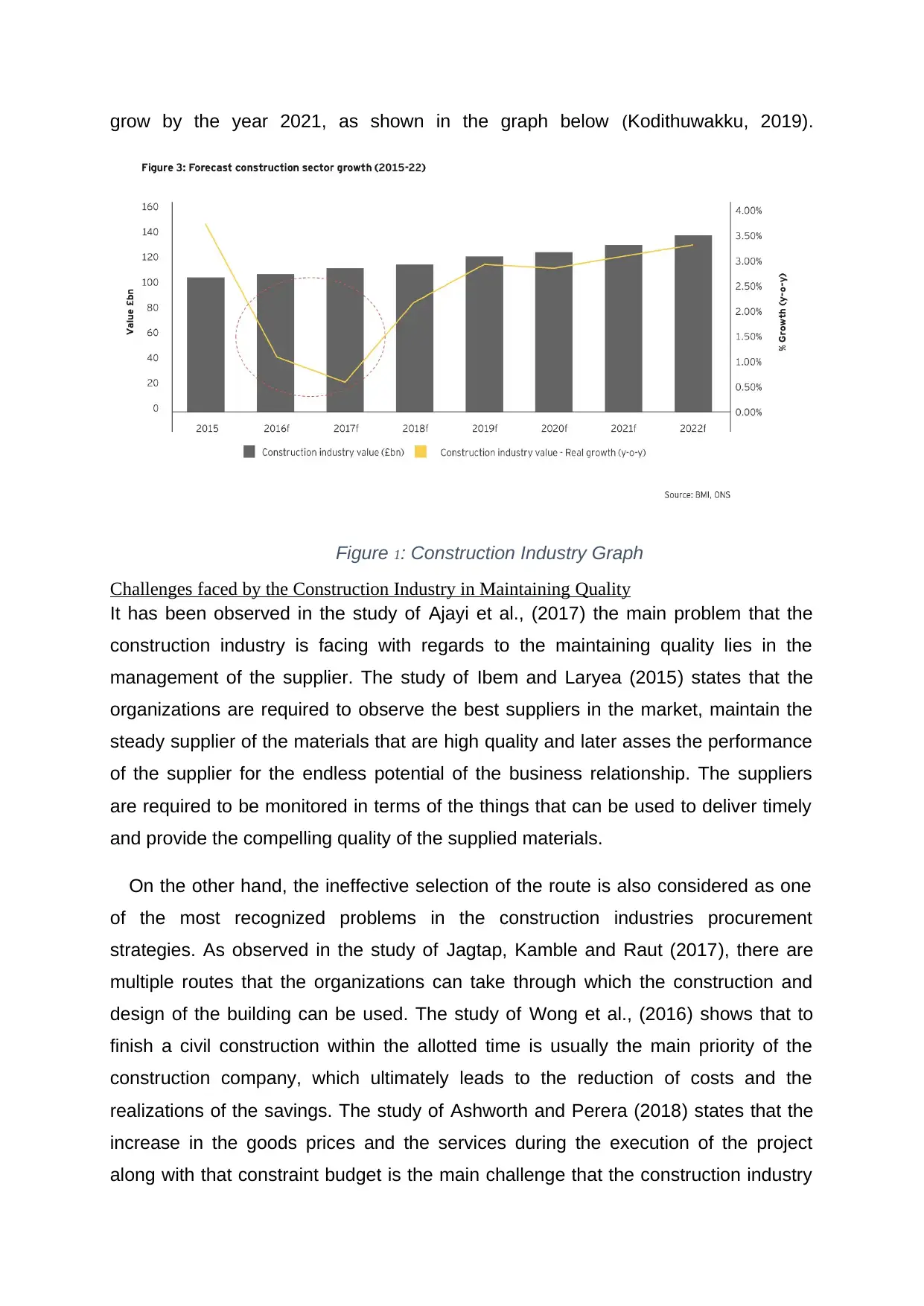
grow by the year 2021, as shown in the graph below (Kodithuwakku, 2019).
Figure 1: Construction Industry Graph
Challenges faced by the Construction Industry in Maintaining Quality
It has been observed in the study of Ajayi et al., (2017) the main problem that the
construction industry is facing with regards to the maintaining quality lies in the
management of the supplier. The study of Ibem and Laryea (2015) states that the
organizations are required to observe the best suppliers in the market, maintain the
steady supplier of the materials that are high quality and later asses the performance
of the supplier for the endless potential of the business relationship. The suppliers
are required to be monitored in terms of the things that can be used to deliver timely
and provide the compelling quality of the supplied materials.
On the other hand, the ineffective selection of the route is also considered as one
of the most recognized problems in the construction industries procurement
strategies. As observed in the study of Jagtap, Kamble and Raut (2017), there are
multiple routes that the organizations can take through which the construction and
design of the building can be used. The study of Wong et al., (2016) shows that to
finish a civil construction within the allotted time is usually the main priority of the
construction company, which ultimately leads to the reduction of costs and the
realizations of the savings. The study of Ashworth and Perera (2018) states that the
increase in the goods prices and the services during the execution of the project
along with that constraint budget is the main challenge that the construction industry
Figure 1: Construction Industry Graph
Challenges faced by the Construction Industry in Maintaining Quality
It has been observed in the study of Ajayi et al., (2017) the main problem that the
construction industry is facing with regards to the maintaining quality lies in the
management of the supplier. The study of Ibem and Laryea (2015) states that the
organizations are required to observe the best suppliers in the market, maintain the
steady supplier of the materials that are high quality and later asses the performance
of the supplier for the endless potential of the business relationship. The suppliers
are required to be monitored in terms of the things that can be used to deliver timely
and provide the compelling quality of the supplied materials.
On the other hand, the ineffective selection of the route is also considered as one
of the most recognized problems in the construction industries procurement
strategies. As observed in the study of Jagtap, Kamble and Raut (2017), there are
multiple routes that the organizations can take through which the construction and
design of the building can be used. The study of Wong et al., (2016) shows that to
finish a civil construction within the allotted time is usually the main priority of the
construction company, which ultimately leads to the reduction of costs and the
realizations of the savings. The study of Ashworth and Perera (2018) states that the
increase in the goods prices and the services during the execution of the project
along with that constraint budget is the main challenge that the construction industry
⊘ This is a preview!⊘
Do you want full access?
Subscribe today to unlock all pages.

Trusted by 1+ million students worldwide
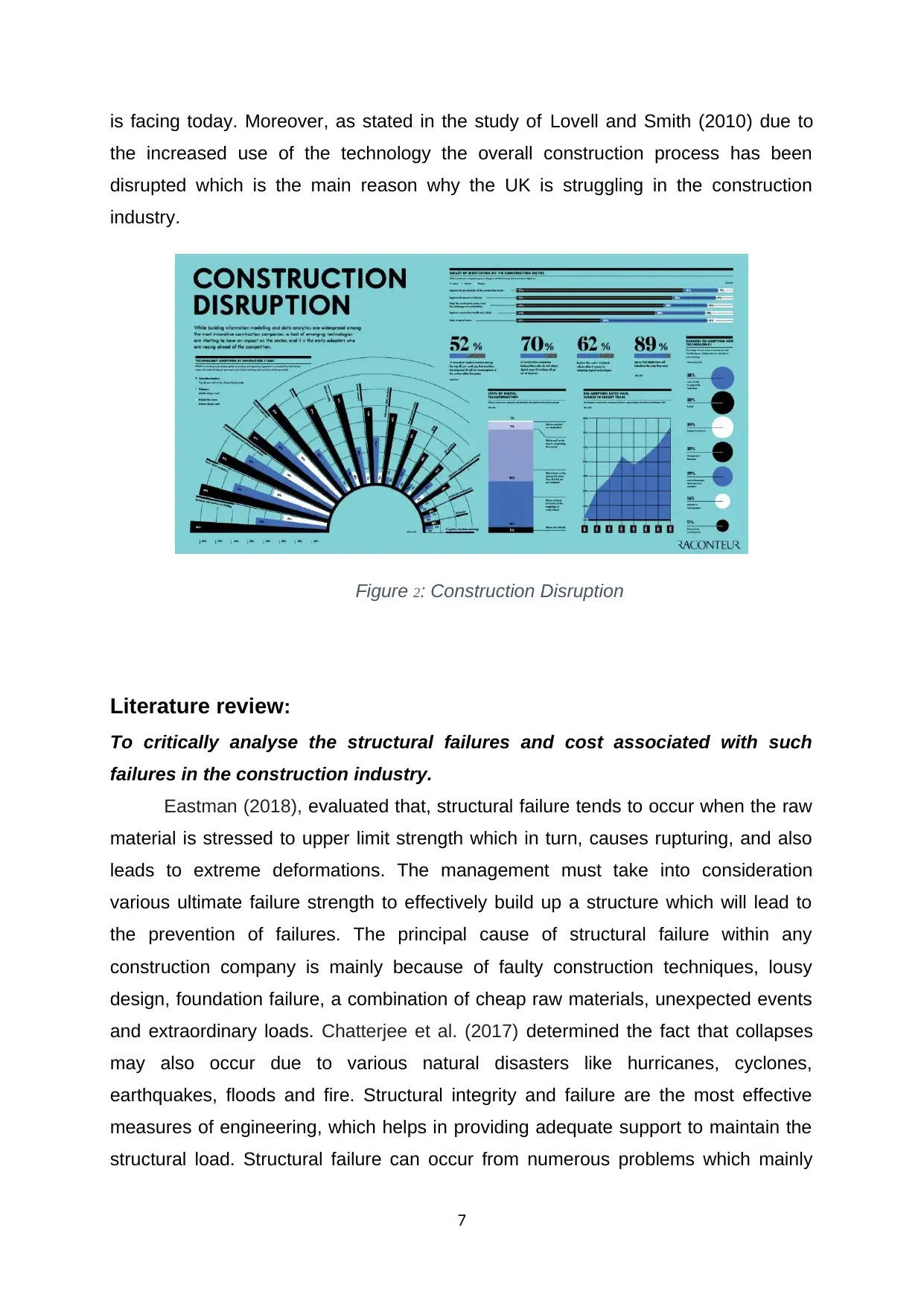
is facing today. Moreover, as stated in the study of Lovell and Smith (2010) due to
the increased use of the technology the overall construction process has been
disrupted which is the main reason why the UK is struggling in the construction
industry.
Figure 2: Construction Disruption
Literature review:
To critically analyse the structural failures and cost associated with such
failures in the construction industry.
Eastman (2018), evaluated that, structural failure tends to occur when the raw
material is stressed to upper limit strength which in turn, causes rupturing, and also
leads to extreme deformations. The management must take into consideration
various ultimate failure strength to effectively build up a structure which will lead to
the prevention of failures. The principal cause of structural failure within any
construction company is mainly because of faulty construction techniques, lousy
design, foundation failure, a combination of cheap raw materials, unexpected events
and extraordinary loads. Chatterjee et al. (2017) determined the fact that collapses
may also occur due to various natural disasters like hurricanes, cyclones,
earthquakes, floods and fire. Structural integrity and failure are the most effective
measures of engineering, which helps in providing adequate support to maintain the
structural load. Structural failure can occur from numerous problems which mainly
7
the increased use of the technology the overall construction process has been
disrupted which is the main reason why the UK is struggling in the construction
industry.
Figure 2: Construction Disruption
Literature review:
To critically analyse the structural failures and cost associated with such
failures in the construction industry.
Eastman (2018), evaluated that, structural failure tends to occur when the raw
material is stressed to upper limit strength which in turn, causes rupturing, and also
leads to extreme deformations. The management must take into consideration
various ultimate failure strength to effectively build up a structure which will lead to
the prevention of failures. The principal cause of structural failure within any
construction company is mainly because of faulty construction techniques, lousy
design, foundation failure, a combination of cheap raw materials, unexpected events
and extraordinary loads. Chatterjee et al. (2017) determined the fact that collapses
may also occur due to various natural disasters like hurricanes, cyclones,
earthquakes, floods and fire. Structural integrity and failure are the most effective
measures of engineering, which helps in providing adequate support to maintain the
structural load. Structural failure can occur from numerous problems which mainly
7
Paraphrase This Document
Need a fresh take? Get an instant paraphrase of this document with our AI Paraphraser
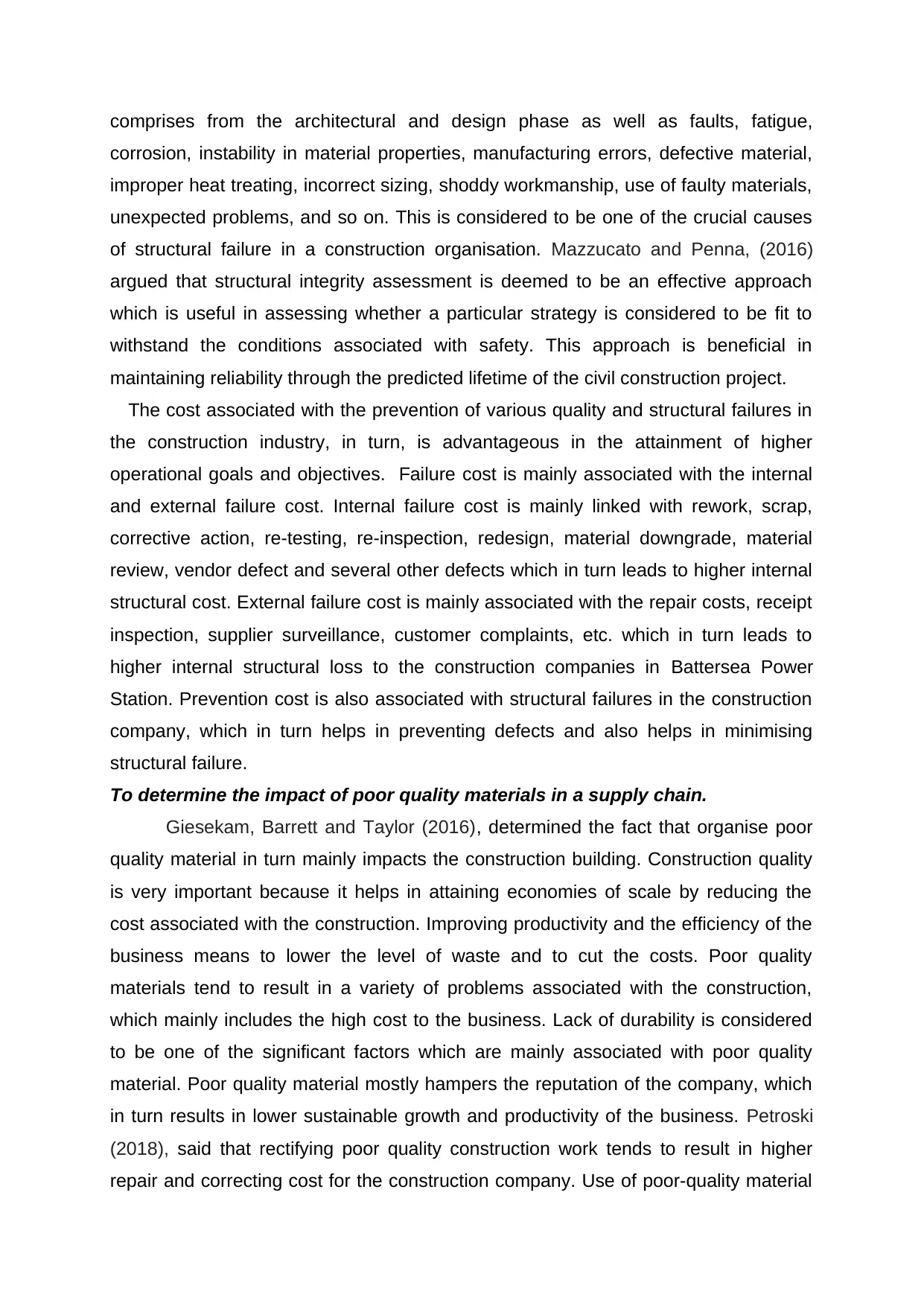
comprises from the architectural and design phase as well as faults, fatigue,
corrosion, instability in material properties, manufacturing errors, defective material,
improper heat treating, incorrect sizing, shoddy workmanship, use of faulty materials,
unexpected problems, and so on. This is considered to be one of the crucial causes
of structural failure in a construction organisation. Mazzucato and Penna, (2016)
argued that structural integrity assessment is deemed to be an effective approach
which is useful in assessing whether a particular strategy is considered to be fit to
withstand the conditions associated with safety. This approach is beneficial in
maintaining reliability through the predicted lifetime of the civil construction project.
The cost associated with the prevention of various quality and structural failures in
the construction industry, in turn, is advantageous in the attainment of higher
operational goals and objectives. Failure cost is mainly associated with the internal
and external failure cost. Internal failure cost is mainly linked with rework, scrap,
corrective action, re-testing, re-inspection, redesign, material downgrade, material
review, vendor defect and several other defects which in turn leads to higher internal
structural cost. External failure cost is mainly associated with the repair costs, receipt
inspection, supplier surveillance, customer complaints, etc. which in turn leads to
higher internal structural loss to the construction companies in Battersea Power
Station. Prevention cost is also associated with structural failures in the construction
company, which in turn helps in preventing defects and also helps in minimising
structural failure.
To determine the impact of poor quality materials in a supply chain.
Giesekam, Barrett and Taylor (2016), determined the fact that organise poor
quality material in turn mainly impacts the construction building. Construction quality
is very important because it helps in attaining economies of scale by reducing the
cost associated with the construction. Improving productivity and the efficiency of the
business means to lower the level of waste and to cut the costs. Poor quality
materials tend to result in a variety of problems associated with the construction,
which mainly includes the high cost to the business. Lack of durability is considered
to be one of the significant factors which are mainly associated with poor quality
material. Poor quality material mostly hampers the reputation of the company, which
in turn results in lower sustainable growth and productivity of the business. Petroski
(2018), said that rectifying poor quality construction work tends to result in higher
repair and correcting cost for the construction company. Use of poor-quality material
corrosion, instability in material properties, manufacturing errors, defective material,
improper heat treating, incorrect sizing, shoddy workmanship, use of faulty materials,
unexpected problems, and so on. This is considered to be one of the crucial causes
of structural failure in a construction organisation. Mazzucato and Penna, (2016)
argued that structural integrity assessment is deemed to be an effective approach
which is useful in assessing whether a particular strategy is considered to be fit to
withstand the conditions associated with safety. This approach is beneficial in
maintaining reliability through the predicted lifetime of the civil construction project.
The cost associated with the prevention of various quality and structural failures in
the construction industry, in turn, is advantageous in the attainment of higher
operational goals and objectives. Failure cost is mainly associated with the internal
and external failure cost. Internal failure cost is mainly linked with rework, scrap,
corrective action, re-testing, re-inspection, redesign, material downgrade, material
review, vendor defect and several other defects which in turn leads to higher internal
structural cost. External failure cost is mainly associated with the repair costs, receipt
inspection, supplier surveillance, customer complaints, etc. which in turn leads to
higher internal structural loss to the construction companies in Battersea Power
Station. Prevention cost is also associated with structural failures in the construction
company, which in turn helps in preventing defects and also helps in minimising
structural failure.
To determine the impact of poor quality materials in a supply chain.
Giesekam, Barrett and Taylor (2016), determined the fact that organise poor
quality material in turn mainly impacts the construction building. Construction quality
is very important because it helps in attaining economies of scale by reducing the
cost associated with the construction. Improving productivity and the efficiency of the
business means to lower the level of waste and to cut the costs. Poor quality
materials tend to result in a variety of problems associated with the construction,
which mainly includes the high cost to the business. Lack of durability is considered
to be one of the significant factors which are mainly associated with poor quality
material. Poor quality material mostly hampers the reputation of the company, which
in turn results in lower sustainable growth and productivity of the business. Petroski
(2018), said that rectifying poor quality construction work tends to result in higher
repair and correcting cost for the construction company. Use of poor-quality material
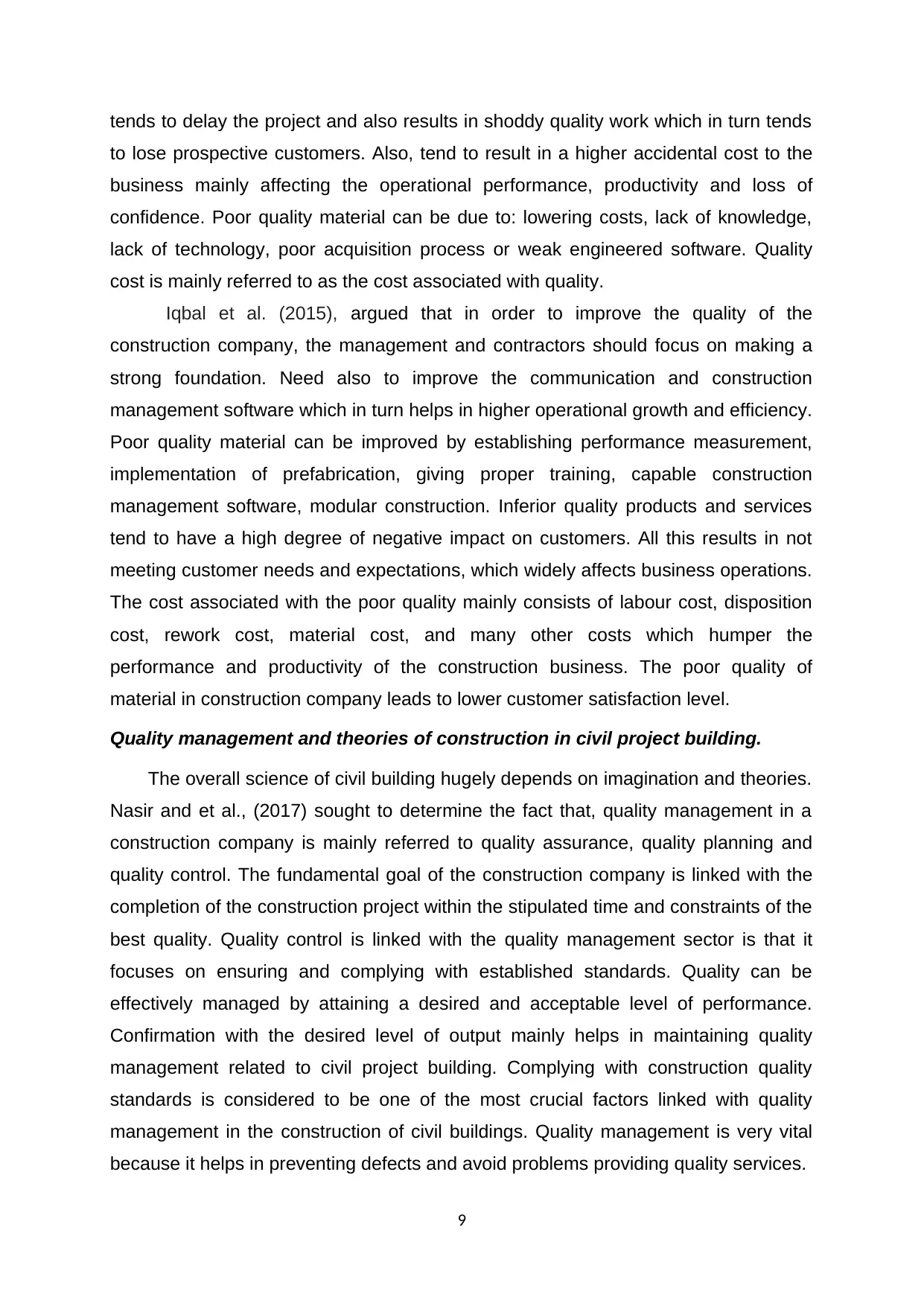
tends to delay the project and also results in shoddy quality work which in turn tends
to lose prospective customers. Also, tend to result in a higher accidental cost to the
business mainly affecting the operational performance, productivity and loss of
confidence. Poor quality material can be due to: lowering costs, lack of knowledge,
lack of technology, poor acquisition process or weak engineered software. Quality
cost is mainly referred to as the cost associated with quality.
Iqbal et al. (2015), argued that in order to improve the quality of the
construction company, the management and contractors should focus on making a
strong foundation. Need also to improve the communication and construction
management software which in turn helps in higher operational growth and efficiency.
Poor quality material can be improved by establishing performance measurement,
implementation of prefabrication, giving proper training, capable construction
management software, modular construction. Inferior quality products and services
tend to have a high degree of negative impact on customers. All this results in not
meeting customer needs and expectations, which widely affects business operations.
The cost associated with the poor quality mainly consists of labour cost, disposition
cost, rework cost, material cost, and many other costs which humper the
performance and productivity of the construction business. The poor quality of
material in construction company leads to lower customer satisfaction level.
Quality management and theories of construction in civil project building.
The overall science of civil building hugely depends on imagination and theories.
Nasir and et al., (2017) sought to determine the fact that, quality management in a
construction company is mainly referred to quality assurance, quality planning and
quality control. The fundamental goal of the construction company is linked with the
completion of the construction project within the stipulated time and constraints of the
best quality. Quality control is linked with the quality management sector is that it
focuses on ensuring and complying with established standards. Quality can be
effectively managed by attaining a desired and acceptable level of performance.
Confirmation with the desired level of output mainly helps in maintaining quality
management related to civil project building. Complying with construction quality
standards is considered to be one of the most crucial factors linked with quality
management in the construction of civil buildings. Quality management is very vital
because it helps in preventing defects and avoid problems providing quality services.
9
to lose prospective customers. Also, tend to result in a higher accidental cost to the
business mainly affecting the operational performance, productivity and loss of
confidence. Poor quality material can be due to: lowering costs, lack of knowledge,
lack of technology, poor acquisition process or weak engineered software. Quality
cost is mainly referred to as the cost associated with quality.
Iqbal et al. (2015), argued that in order to improve the quality of the
construction company, the management and contractors should focus on making a
strong foundation. Need also to improve the communication and construction
management software which in turn helps in higher operational growth and efficiency.
Poor quality material can be improved by establishing performance measurement,
implementation of prefabrication, giving proper training, capable construction
management software, modular construction. Inferior quality products and services
tend to have a high degree of negative impact on customers. All this results in not
meeting customer needs and expectations, which widely affects business operations.
The cost associated with the poor quality mainly consists of labour cost, disposition
cost, rework cost, material cost, and many other costs which humper the
performance and productivity of the construction business. The poor quality of
material in construction company leads to lower customer satisfaction level.
Quality management and theories of construction in civil project building.
The overall science of civil building hugely depends on imagination and theories.
Nasir and et al., (2017) sought to determine the fact that, quality management in a
construction company is mainly referred to quality assurance, quality planning and
quality control. The fundamental goal of the construction company is linked with the
completion of the construction project within the stipulated time and constraints of the
best quality. Quality control is linked with the quality management sector is that it
focuses on ensuring and complying with established standards. Quality can be
effectively managed by attaining a desired and acceptable level of performance.
Confirmation with the desired level of output mainly helps in maintaining quality
management related to civil project building. Complying with construction quality
standards is considered to be one of the most crucial factors linked with quality
management in the construction of civil buildings. Quality management is very vital
because it helps in preventing defects and avoid problems providing quality services.
9
⊘ This is a preview!⊘
Do you want full access?
Subscribe today to unlock all pages.

Trusted by 1+ million students worldwide
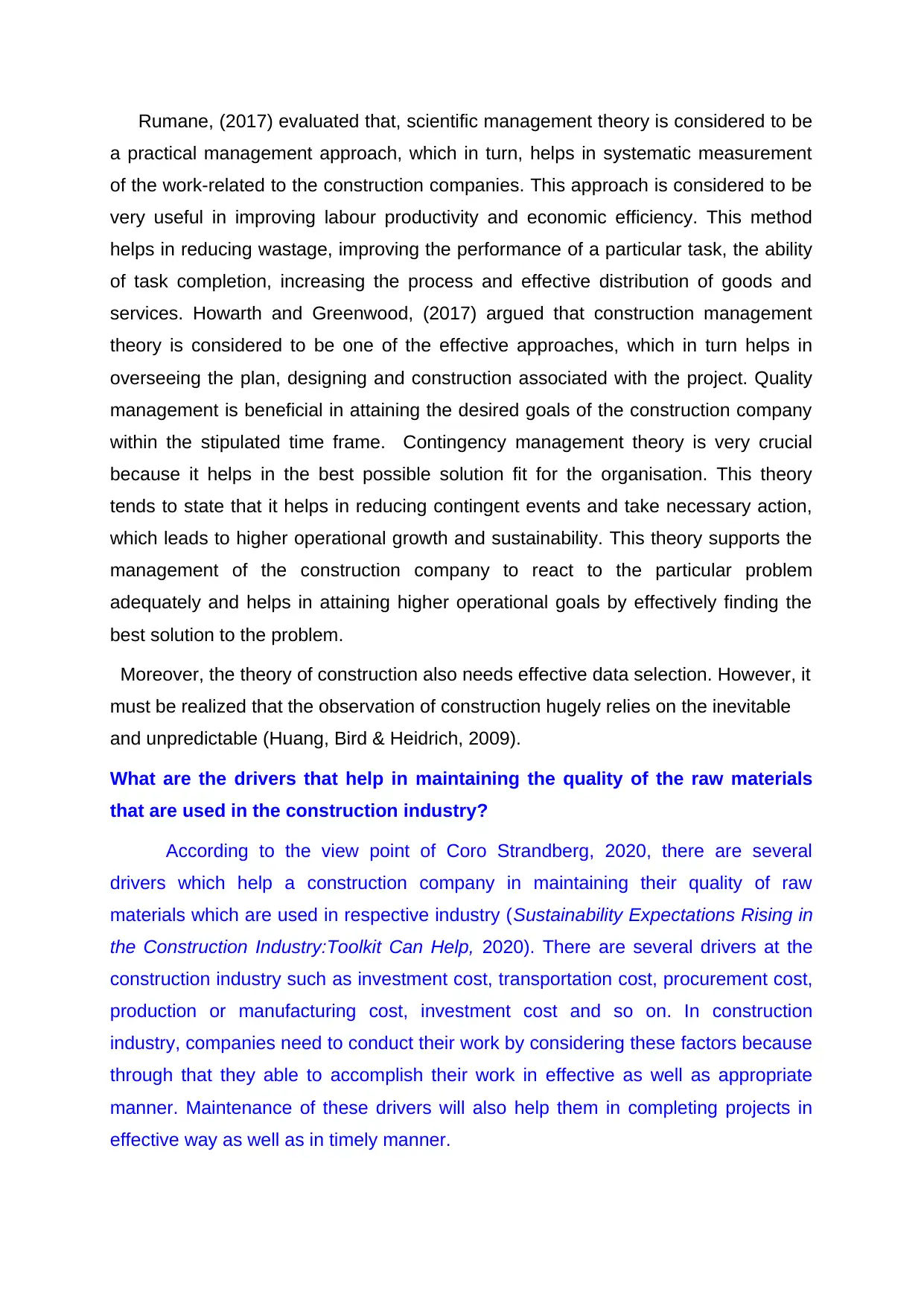
Rumane, (2017) evaluated that, scientific management theory is considered to be
a practical management approach, which in turn, helps in systematic measurement
of the work-related to the construction companies. This approach is considered to be
very useful in improving labour productivity and economic efficiency. This method
helps in reducing wastage, improving the performance of a particular task, the ability
of task completion, increasing the process and effective distribution of goods and
services. Howarth and Greenwood, (2017) argued that construction management
theory is considered to be one of the effective approaches, which in turn helps in
overseeing the plan, designing and construction associated with the project. Quality
management is beneficial in attaining the desired goals of the construction company
within the stipulated time frame. Contingency management theory is very crucial
because it helps in the best possible solution fit for the organisation. This theory
tends to state that it helps in reducing contingent events and take necessary action,
which leads to higher operational growth and sustainability. This theory supports the
management of the construction company to react to the particular problem
adequately and helps in attaining higher operational goals by effectively finding the
best solution to the problem.
Moreover, the theory of construction also needs effective data selection. However, it
must be realized that the observation of construction hugely relies on the inevitable
and unpredictable (Huang, Bird & Heidrich, 2009).
What are the drivers that help in maintaining the quality of the raw materials
that are used in the construction industry?
According to the view point of Coro Strandberg, 2020, there are several
drivers which help a construction company in maintaining their quality of raw
materials which are used in respective industry (Sustainability Expectations Rising in
the Construction Industry:Toolkit Can Help, 2020). There are several drivers at the
construction industry such as investment cost, transportation cost, procurement cost,
production or manufacturing cost, investment cost and so on. In construction
industry, companies need to conduct their work by considering these factors because
through that they able to accomplish their work in effective as well as appropriate
manner. Maintenance of these drivers will also help them in completing projects in
effective way as well as in timely manner.
a practical management approach, which in turn, helps in systematic measurement
of the work-related to the construction companies. This approach is considered to be
very useful in improving labour productivity and economic efficiency. This method
helps in reducing wastage, improving the performance of a particular task, the ability
of task completion, increasing the process and effective distribution of goods and
services. Howarth and Greenwood, (2017) argued that construction management
theory is considered to be one of the effective approaches, which in turn helps in
overseeing the plan, designing and construction associated with the project. Quality
management is beneficial in attaining the desired goals of the construction company
within the stipulated time frame. Contingency management theory is very crucial
because it helps in the best possible solution fit for the organisation. This theory
tends to state that it helps in reducing contingent events and take necessary action,
which leads to higher operational growth and sustainability. This theory supports the
management of the construction company to react to the particular problem
adequately and helps in attaining higher operational goals by effectively finding the
best solution to the problem.
Moreover, the theory of construction also needs effective data selection. However, it
must be realized that the observation of construction hugely relies on the inevitable
and unpredictable (Huang, Bird & Heidrich, 2009).
What are the drivers that help in maintaining the quality of the raw materials
that are used in the construction industry?
According to the view point of Coro Strandberg, 2020, there are several
drivers which help a construction company in maintaining their quality of raw
materials which are used in respective industry (Sustainability Expectations Rising in
the Construction Industry:Toolkit Can Help, 2020). There are several drivers at the
construction industry such as investment cost, transportation cost, procurement cost,
production or manufacturing cost, investment cost and so on. In construction
industry, companies need to conduct their work by considering these factors because
through that they able to accomplish their work in effective as well as appropriate
manner. Maintenance of these drivers will also help them in completing projects in
effective way as well as in timely manner.
Paraphrase This Document
Need a fresh take? Get an instant paraphrase of this document with our AI Paraphraser
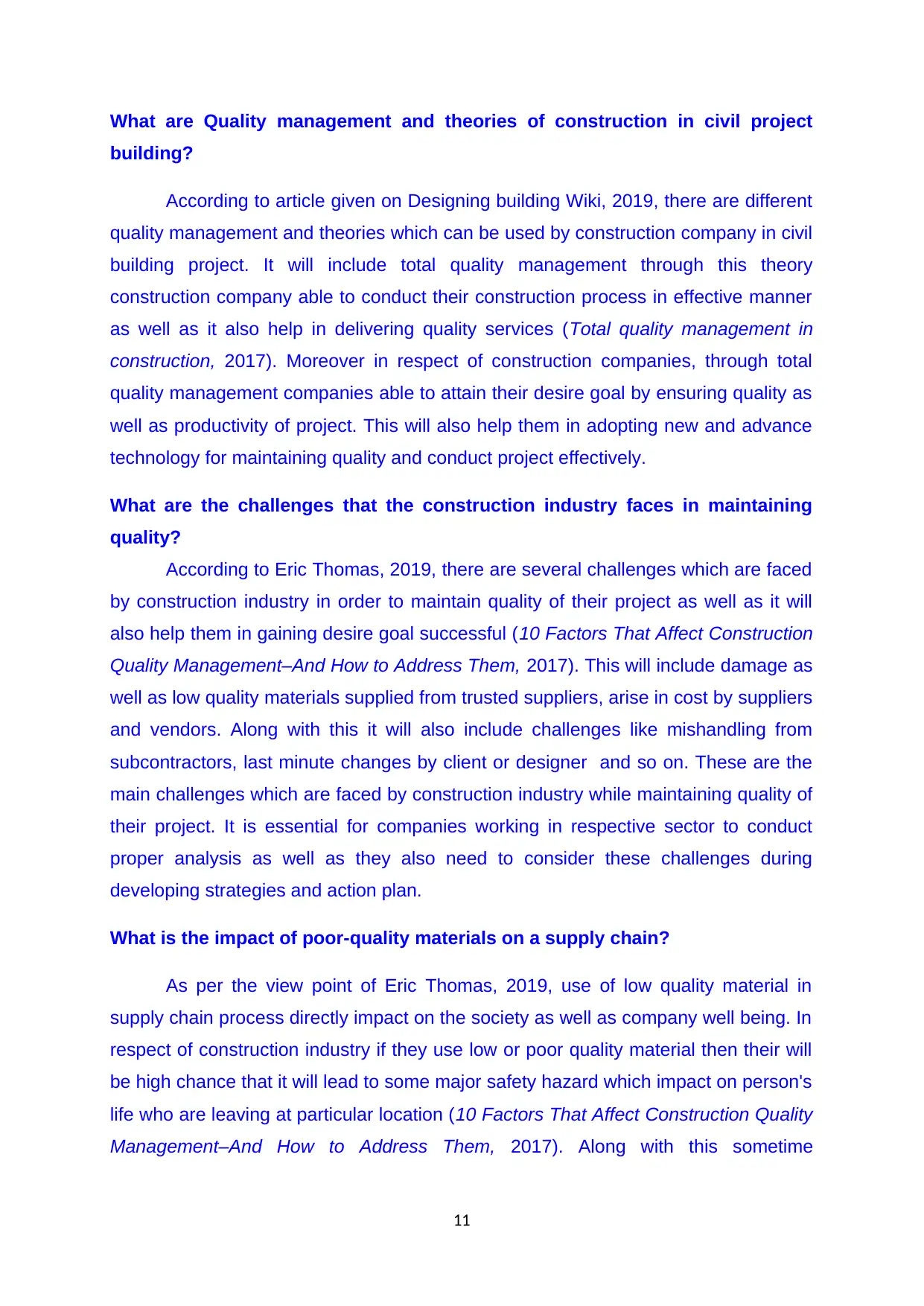
What are Quality management and theories of construction in civil project
building?
According to article given on Designing building Wiki, 2019, there are different
quality management and theories which can be used by construction company in civil
building project. It will include total quality management through this theory
construction company able to conduct their construction process in effective manner
as well as it also help in delivering quality services (Total quality management in
construction, 2017). Moreover in respect of construction companies, through total
quality management companies able to attain their desire goal by ensuring quality as
well as productivity of project. This will also help them in adopting new and advance
technology for maintaining quality and conduct project effectively.
What are the challenges that the construction industry faces in maintaining
quality?
According to Eric Thomas, 2019, there are several challenges which are faced
by construction industry in order to maintain quality of their project as well as it will
also help them in gaining desire goal successful (10 Factors That Affect Construction
Quality Management–And How to Address Them, 2017). This will include damage as
well as low quality materials supplied from trusted suppliers, arise in cost by suppliers
and vendors. Along with this it will also include challenges like mishandling from
subcontractors, last minute changes by client or designer and so on. These are the
main challenges which are faced by construction industry while maintaining quality of
their project. It is essential for companies working in respective sector to conduct
proper analysis as well as they also need to consider these challenges during
developing strategies and action plan.
What is the impact of poor-quality materials on a supply chain?
As per the view point of Eric Thomas, 2019, use of low quality material in
supply chain process directly impact on the society as well as company well being. In
respect of construction industry if they use low or poor quality material then their will
be high chance that it will lead to some major safety hazard which impact on person's
life who are leaving at particular location (10 Factors That Affect Construction Quality
Management–And How to Address Them, 2017). Along with this sometime
11
building?
According to article given on Designing building Wiki, 2019, there are different
quality management and theories which can be used by construction company in civil
building project. It will include total quality management through this theory
construction company able to conduct their construction process in effective manner
as well as it also help in delivering quality services (Total quality management in
construction, 2017). Moreover in respect of construction companies, through total
quality management companies able to attain their desire goal by ensuring quality as
well as productivity of project. This will also help them in adopting new and advance
technology for maintaining quality and conduct project effectively.
What are the challenges that the construction industry faces in maintaining
quality?
According to Eric Thomas, 2019, there are several challenges which are faced
by construction industry in order to maintain quality of their project as well as it will
also help them in gaining desire goal successful (10 Factors That Affect Construction
Quality Management–And How to Address Them, 2017). This will include damage as
well as low quality materials supplied from trusted suppliers, arise in cost by suppliers
and vendors. Along with this it will also include challenges like mishandling from
subcontractors, last minute changes by client or designer and so on. These are the
main challenges which are faced by construction industry while maintaining quality of
their project. It is essential for companies working in respective sector to conduct
proper analysis as well as they also need to consider these challenges during
developing strategies and action plan.
What is the impact of poor-quality materials on a supply chain?
As per the view point of Eric Thomas, 2019, use of low quality material in
supply chain process directly impact on the society as well as company well being. In
respect of construction industry if they use low or poor quality material then their will
be high chance that it will lead to some major safety hazard which impact on person's
life who are leaving at particular location (10 Factors That Affect Construction Quality
Management–And How to Address Them, 2017). Along with this sometime
11
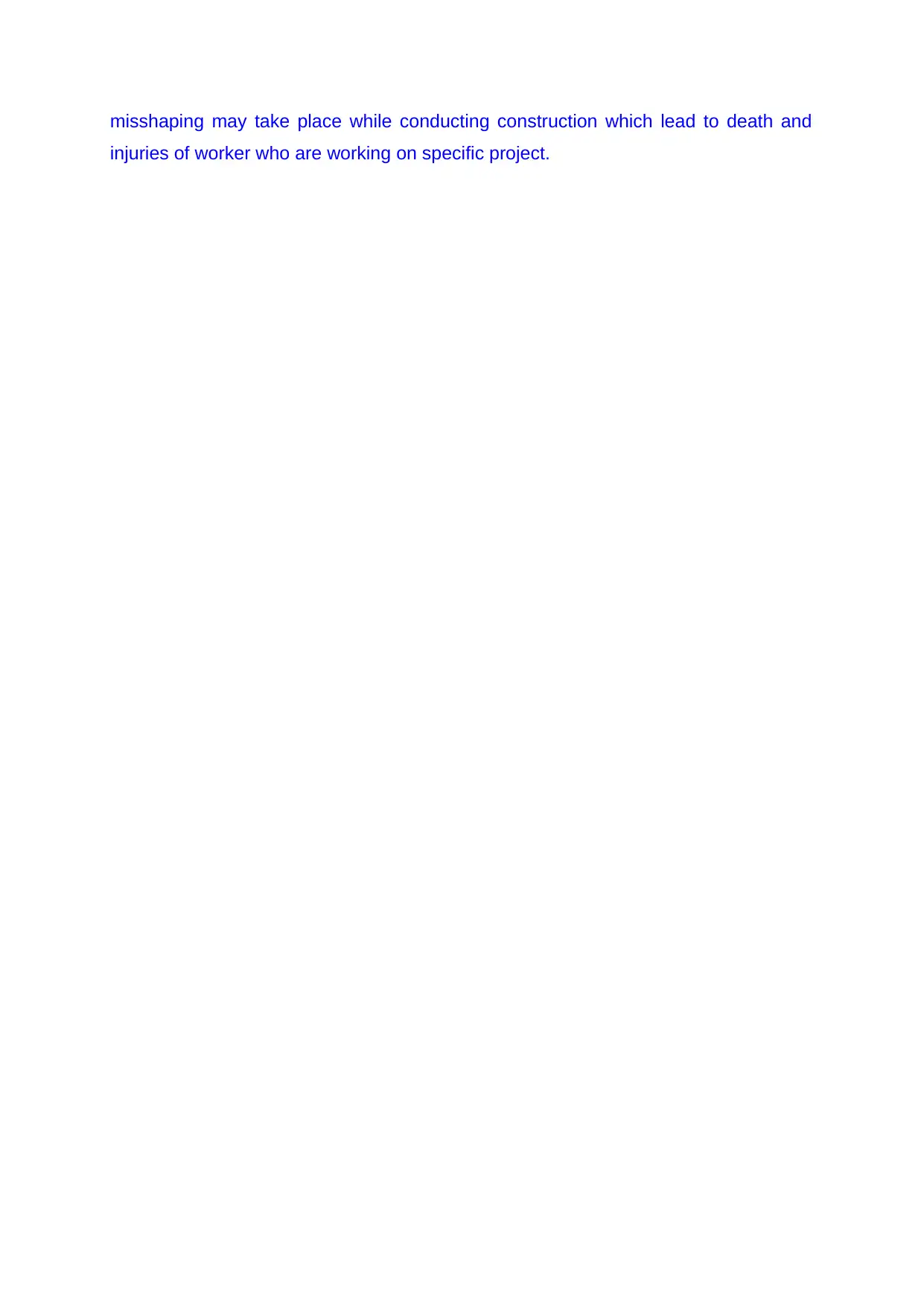
misshaping may take place while conducting construction which lead to death and
injuries of worker who are working on specific project.
injuries of worker who are working on specific project.
⊘ This is a preview!⊘
Do you want full access?
Subscribe today to unlock all pages.

Trusted by 1+ million students worldwide
1 out of 31
Related Documents
Your All-in-One AI-Powered Toolkit for Academic Success.
+13062052269
info@desklib.com
Available 24*7 on WhatsApp / Email
![[object Object]](/_next/static/media/star-bottom.7253800d.svg)
Unlock your academic potential
Copyright © 2020–2025 A2Z Services. All Rights Reserved. Developed and managed by ZUCOL.





